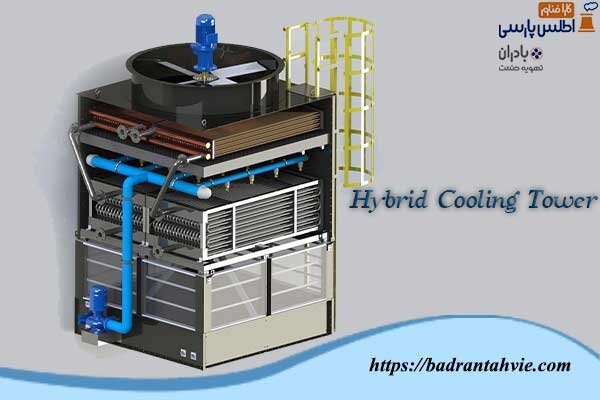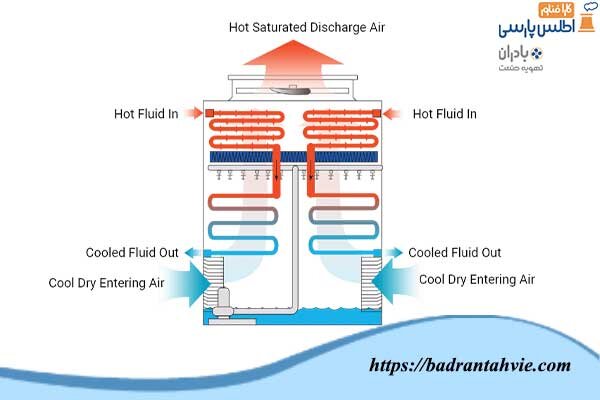Why Choose Hybrid Cooling Towers?

The hybrid design combines dry cooling with wet cooling in a common casing. The hot water flow passes the system in series, starting hot in the dry section located outside of the cooling tower casing just above the drift eliminators.
What is Hybrid Cooling Tower? Hybrid cooling combines dry and evaporative cooling to produce cooling power and reduce water and energy consumption. All over the world, we are all more aware of our water consumption, as drinking water is recognized as a crucial natural resource; the use of hybrid cooling solutions, where applicable, can dramatically reduce annual water consumption.
Application in Cooling Towers
In industrial refrigeration, evaporative coolers are used, which can run both wet and dry. Hybrid cooling distinguishes between two operating modes:
- Dry cooler with wet trim
- Wet cooler with dry trim
Dry Cooler with Wet Trim
The method of choice for anyone whose top priority is the saving of water: the dry cooler with wet trim puts the dry cooling coil in series with the evaporative cooling tube bundle; The dry tube bundle is an integral part of the cooling system and should not be switched on or off alternately. Laminated tube bundles are located above the pressurized water distribution system, and alone are capable of transporting a significant portion of the cooling capacity. (Process) medium passes from the dry tube bundle into the wet tube bundle below the pressurized water distribution system, where, depending on the current unit load, is cooled by evaporative cooling or further dry cooling capacity. An additional advantage of this system is the significantly higher temperature of the transition to the bulb.
Wet Cooler with Dry Trim
In a wet, dry-trim cooler, the unit is able to run simultaneously in wet and dry mode due to the separate spray sections above the tube bundles. The tube bundles can either be used for evaporation or dry cooling, not both at the same time. Depending on the power requirements, the device must either run completely in dry mode, 50% of the unit in wet mode or the entire unit in wet mode. The end result is a significant decrease in water consumption compared to pure evaporative cooling units.
A hybrid cooling tower is a cooling system that leverages wet and dry cooling technologies to reduce both the plume volumes and the consumption of water, minimizing the impact on the environment. Air enters from both the wet and dry sections of the tower. The air coming from the lower sections passes through the wet section before reaching the upper dry section. The air from the wet and dry sections rises and mixes above the fan, resulting in little or no visible plume.
Plume
Visible plume is essentially pure water vapor discharged from cooling towers during operation. It is visible when the moist heated air mass leaving the tower is cooled below its dew point. Visible plume is most prevalent during winter periods, when warmer moist air mixes with colder ambient air. Visible plume discharged from a cooling tower is not an air pollutant. Through plume, cooling towers add heat and moisture to the surrounding environment.
In hybrid cooling towers, the dried and warmed air flow produced within the dry section tube bundles mixes with the dried out saturated air from the wet section to reduce plume formation. The mixed and unsaturated air leaving the hybrid tower leverages the combined cooling effects of both wet and dry sections, thus even if cooled by surrounding ambient, air will not become supersaturated, and no visible fog will occur. Hybrid cooling towers are specifically designed to avoid visible plume in cold, humid, ambient conditions and when local constraints require this technology, such as at airports or residential areas.
Water Consumption

The hybridization of a cooling tower is the transition from a full wet cooling tower to a hybrid cooling tower. SPIG cooling system hybridizations minimize environmental impact with the addition of a dry section to wet cooling towers. These dry sections are basically conventional air-cooled heat exchangers located in the upper part of the structure above the drift eliminators. The dry section is equipped with dampers to control the air flow in accordance with the actual environmental conditions.
The maximum hybrid cooling tower thermal performance, calculated through the cold-water temperature leaving the tower, is achieved when the cooling tower runs in a wet configuration, with dampers totally closed. On the other hand, the maximum plume abatement capability is achieved when the air flow is delivered to the dry section, with dampers totally opened. A vacuum system is added to the tower to remove air from the top of tube bundles both during the start-up sequence and during the normal operation to control proper water volumes in the dry section.
The hybrid design combines dry cooling with wet cooling in a common casing. The hot water flow passes the system in series, starting hot in the dry section located outside of the cooling tower casing just above the drift eliminators. Then, the pre-cooled water is fed to the distribution system and discharged on the fill media of the wet section. A skid vacuum system must be provided to create and maintain the siphon effect in the tube bundles (dry section) which allows the circulating water pumps to run at lower pump head.
Summary
A hybrid cooling tower is therefore beneficial when it is necessary to limit the use of water and to reduce or eliminate the plume coming out from fan stacks. Hybrid cooling towers, present environmental benefits with reduced water consumption and plume abatement.In some applications, the water savings generated with hybrid cooling towers offsets the higher construction cost.
برچسب ها : Hybrid Cooling Tower,cooling tower
Leave a Comment